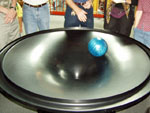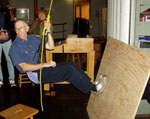 Gravity
well Exhibit Exploration, Discover
Kepler's Laws in a funnel.
Gravity
well Exhibit Exploration, Discover
Kepler's Laws in a funnel. Moonwalk,
feel what it is like to stand and jump on the moon.
Moonwalk,
feel what it is like to stand and jump on the moon.Geology of Earth and Planets
With Paul Doherty, John Lahr, and Modesto Tamez
This set of lessons is available online at http://www.exo.net/~pauld
The present is the key to the past.
James Hutton 1785
All you need to know about geology
The Rocks on the summit of Mt. Everest are Marine Limestone.
John McPhee
A draft plan of what we might do.
Day 1 Introductions of participants: Planets, orbits, rotations, web resources. How Planets Form:
Hydrogen is an odorless, colorless gas that after 13 billion years produces people. Carl Sagan
 Gravity
well Exhibit Exploration, Discover
Kepler's Laws in a funnel.
Gravity
well Exhibit Exploration, Discover
Kepler's Laws in a funnel. Moonwalk,
feel what it is like to stand and jump on the moon.
Moonwalk,
feel what it is like to stand and jump on the moon.Day 2 Planetary Magnetism, radioactive dating
Atomic Theory: "All ordinary matter is made of atoms, small indivisible particles which attract each other when a little ways apart and repel each other when close." Richard Feynman
 Where's
North?, hang magnets and they all hang
in the same orientation.
Where's
North?, hang magnets and they all hang
in the same orientation. Magnetic
field of planets, images of planetary
magnetic fields.
Magnetic
field of planets, images of planetary
magnetic fields.Day 3 Gravity, tides, cratering, icy bodies, atmosphere, hydrosphere,cryosphere
In the outer solar system think of liquid water as molten ice. Phil Karlton
 PD
craters, drop steel ball bearings into
spice-covered salt to study impact craters.
PD
craters, drop steel ball bearings into
spice-covered salt to study impact craters. Icy
bodies, use dry ice on warm water to
make patterns like comets with tails.
Icy
bodies, use dry ice on warm water to
make patterns like comets with tails.Day 4 Seismology, earth's interior,
 Slinky
models, model earthquake waves with
slinkies, P, S, Raleigh and Love. See also Seismic
Slinky
Slinky
models, model earthquake waves with
slinkies, P, S, Raleigh and Love. See also Seismic
SlinkyDay 5 Teachers present lessons.
Day 6 Planetary Atmospheres, Volcanos MT
 Polyurethane
foam volcano, liquids which create foam
when mixed can be purchased at TAP plastics. Mix them in a cup
then cover the cup with sand and watch the eruption.
Polyurethane
foam volcano, liquids which create foam
when mixed can be purchased at TAP plastics. Mix them in a cup
then cover the cup with sand and watch the eruption. Chocolate
Volcano, Make double strength clear
Jell-O, inject chocolate pudding from a syringe from below,
observe dikes and sill.
Chocolate
Volcano, Make double strength clear
Jell-O, inject chocolate pudding from a syringe from below,
observe dikes and sill.Day 7 Mapping part 1
Day 8 Mapping p2 MT
Day 9 Subway to Subduction SF, Marin, triangulation.
Day 10 Teachers present lessons.
Web Resources, a compilation of information on the web about planetary geology.
|
Scientific Explorations with Paul Doherty |
|
16 July 2002 |